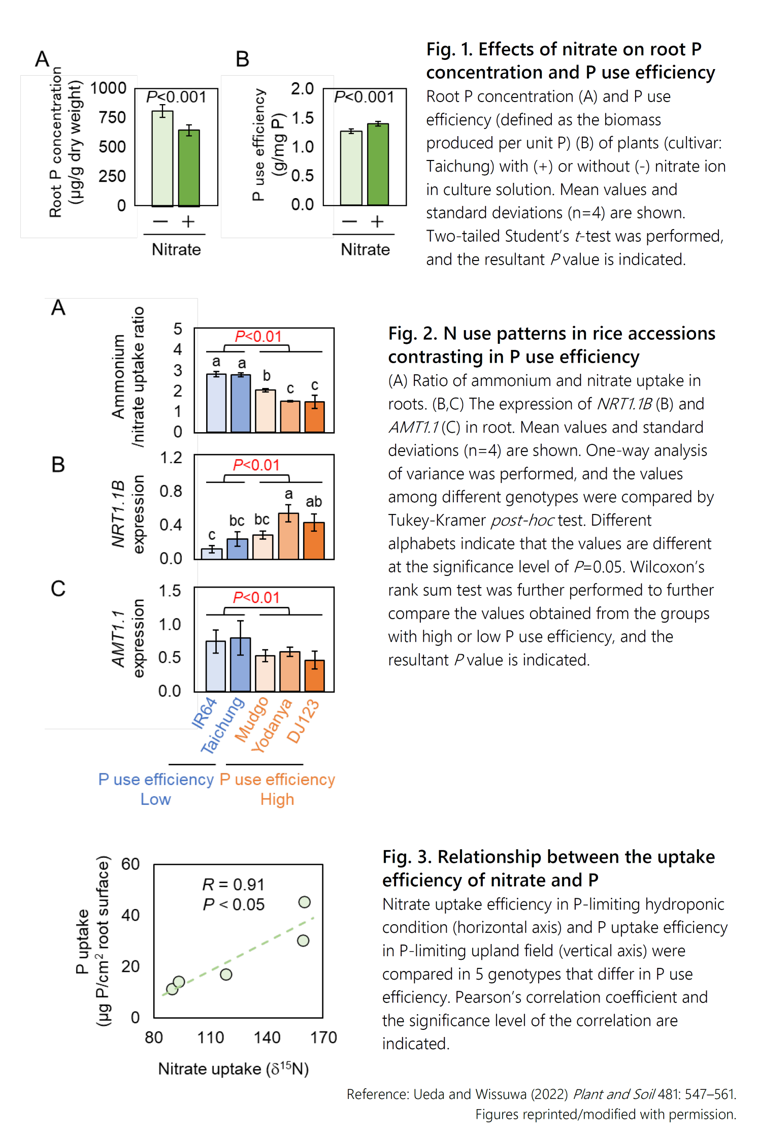Nitrate uptake positively correlates with phosphorus use efficiency in rice
Description
Phosphorus (P) is one of the essential elements for plants but is frequently deficient in agricultural fields. P fertilizer is expected to be depleted in the future, and in light of the soaring cost of fertilizers, farmers cannot apply sufficient P fertilizers in many developing countries where food security is particularly threatening. Thus, for the production of rice, which is the major agricultural crop in many of these developing countries lacking ample supply of P, developing P-efficient rice variety that efficiently absorb P and/or efficiently produce biomass with limited amount of P is a promising approach. However, previous investigations suggest that P use efficiency in rice is controlled by many small-effect genetic factors, thus rendering a conventional breeding approach of limited use. Our previous metabolomics study showed that several amino acids and nitrogen (N)-containing metabolites serve as markers for P use efficiency, suggesting that N utilization might be a key for efficiency use of P. Therefore, in the current study, we examined the effect of different N sources on P use efficiency.
Addition of nitrate lowered root P concentration under low P supply compared with the condition when the same amount of N was applied solely as ammonium (Fig. 1A). This resulted in higher P use efficiency in nitrate-treated plants (Fig. 1B). Comparison of gene expression patterns in 5 rice accessions that differ in P use efficiency showed that, compared with P-inefficient genotypes such as IR64 and Taichung, P-efficient genotypes such as DJ123, Mudgo, and Yodanya had lower uptake ratio of ammonium to nitrate (Fig. 2A). Accordingly, the expression of NRT1.1B, which encodes a nitrate transporter that likely highly contributes to nitrate uptake, was higher in P-efficient genotypes than P-inefficient genotypes (Fig. 2B). On the other hand, the expression of AMT1.1 that encodes one of the major ammonium transporters tended to be lower in P-efficient genotypes (Fig. 2C).
A strong positive correlation was observed between the uptake efficiency of nitrate examined under the hydroponic condition and P uptake efficiency previously examined in a low P field (Fig. 3). These observations suggest that utilization of nitrate and P are interconnected, and improvement of nitrate use may increase P use efficiency. This is in accordance with a previous hypothesis that nitrate uptake increases P solubilization in the rhizosphere and contributes to increased P uptake. Further studies are necessary to confirm if altered N fertilization scheme affects P use efficiency of rice in the field and to discover the causal gene for such genotypic differences.
Figure, table
- Research project
- Program name
- Budget
-
交付金
- Term of research
-
FY2020–2022年度
- Responsible researcher
-
Ueda Yoshiaki ( Crop, Livestock and Environment Division )
Wissuwa Matthias ( Crop, Livestock and Environment Division )
KAKEN Researcher No.: 90442722 - ほか
- Publication, etc.
-
Ueda and Wissuwa (2022) Plant and Soil 481: 547–561.https://doi.org/10.1007/s11104-022-05655-3
- Japanese PDF
-
2022_B04_ja.pdf632.27 KB
- English PDF
-
2022_B04_en.pdf377.52 KB
* Affiliation at the time of implementation of the study.

